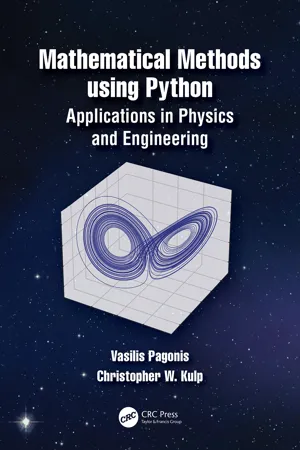
Mathematical Methods using Python
Applications in Physics and Engineering
- 504 pages
- English
- ePUB (mobile friendly)
- Available on iOS & Android
Mathematical Methods using Python
Applications in Physics and Engineering
About this book
This advanced undergraduate textbook presents a new approach to teaching mathematical methods for scientists and engineers. It provides a practical, pedagogical introduction to utilizing Python in Mathematical and Computational Methods courses. Both analytical and computational examples are integrated from its start. Each chapter concludes with a set of problems designed to help students hone their skills in mathematical techniques, computer programming, and numerical analysis. The book places less emphasis on mathematical proofs, and more emphasis on how to use computers for both symbolic and numerical calculations. It contains 182 extensively documented coding examples, based on topics that students will encounter in their advanced courses in Mechanics, Electronics, Optics, Electromagnetism, Quantum Mechanics etc.
An introductory chapter gives students a crash course in Python programming and the most often used libraries (SymPy, NumPy, SciPy, Matplotlib). This is followed by chapters dedicated to differentiation, integration, vectors and multiple integration techniques. The next group of chapters covers complex numbers, matrices, vector analysis and vector spaces. Extensive chapters cover ordinary and partial differential equations, followed by chapters on nonlinear systems and on the analysis of experimental data using linear and nonlinear regression techniques, Fourier transforms, binomial and Gaussian distributions. The book is accompanied by a dedicated GitHub website, which contains all codes from the book in the form of ready to run Jupyter notebooks. A detailed solutions manual is also available for instructors using the textbook in their courses.
Key Features:
- A unique teaching approach which merges mathematical methods and the Python programming skills which physicists and engineering students need in their courses
- Uses examples and models from physical and engineering systems, to motivate the mathematics being taught
- Students learn to solve scientific problems in three different ways: traditional pen-and-paper methods, using scientific numerical techniques with NumPy and SciPy, and using Symbolic Python (SymPy).
Frequently asked questions
- Essential is ideal for learners and professionals who enjoy exploring a wide range of subjects. Access the Essential Library with 800,000+ trusted titles and best-sellers across business, personal growth, and the humanities. Includes unlimited reading time and Standard Read Aloud voice.
- Complete: Perfect for advanced learners and researchers needing full, unrestricted access. Unlock 1.4M+ books across hundreds of subjects, including academic and specialized titles. The Complete Plan also includes advanced features like Premium Read Aloud and Research Assistant.
Please note we cannot support devices running on iOS 13 and Android 7 or earlier. Learn more about using the app.
Information
Table of contents
- Cover Page
- Half-Title Page
- Title Page
- Copyright Page
- Dedication Page
- Contents
- Preface
- Chapter 1 Introduction to Python
- Chapter 2 Differentiation
- Chapter 3 Integration
- Chapter 4 Vectors
- Chapter 5 Multiple Integrals
- Chapter 6 Complex Numbers
- Chapter 7 Matrices
- Chapter 8 Vector Analysis
- Chapter 9 Vector Spaces
- Chapter 10 Ordinary Differential Equations
- Chapter 11 Partial Differential Equations
- Chapter 12 Analysis of Nonlinear Systems
- Chapter 13 Analysis of Experimental Data
- Further Reading and Additional Resources
- Index